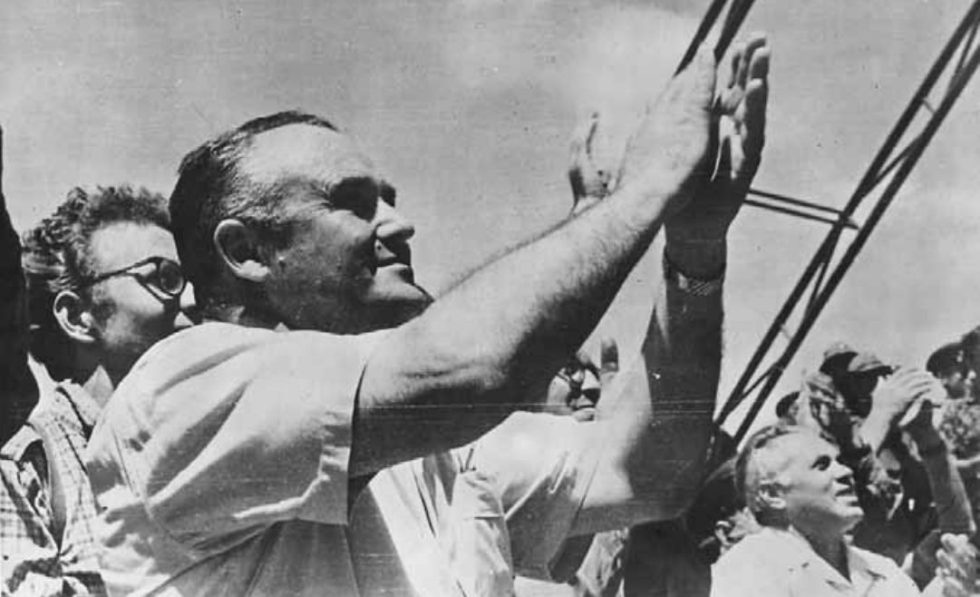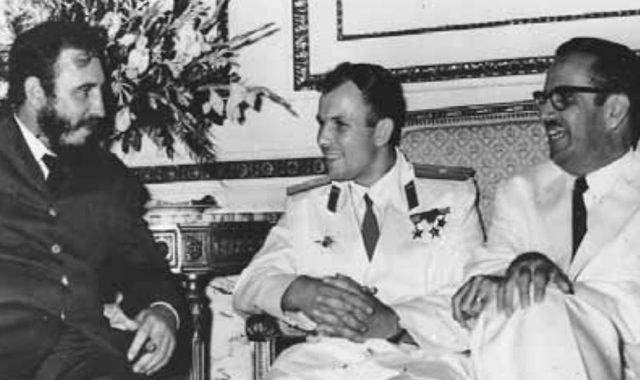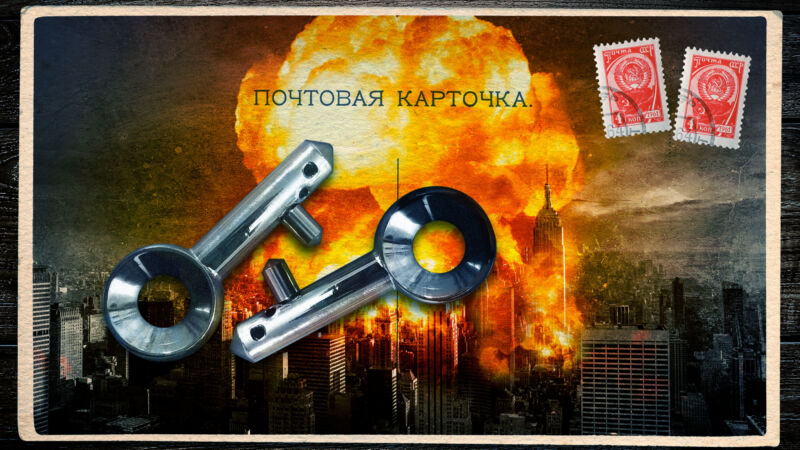The world will mark the 60th anniversary of the Cuban Missile Crisis, which is known to Russians as the Caribbean Crisis, in October. The incredibly tense confrontation brought the United States and the Soviet Union to the brink of nuclear war.
The crisis has fresh relevance today in the weeks after Russia's unprovoked invasion of Ukraine. Russian President Vladimir Putin has indicated that using his country's nuclear weapons stockpile is a possibility, and Western experts have not disputed that such use could happen.
While Putin employing nuclear weapons remains unlikely, experts say some situations may cause the Russian leader to lash out. These include Russia losing the war badly, the country being crushed by economic sanctions, or Putin feeling as though his hold on power is threatened. Were some or all of these things to happen, Putin could conceivably turn to his option of last resort. A nuclear strike could take the form of a demonstration over an unpopulated area, or perhaps even a tactical blow in Ukraine. Such a move would almost certainly force a response from the West.
And then? Well, bad things, probably.
To understand just how quickly things could spiral out of control, it's instructive to revisit the Cuban Missile Crisis. But this article will not cover the well-worn historical path of the conflict itself. Instead, it will offer a look into the Russian side of the story from the perspective of the space program, which was trying to launch a series of Mars probes in October 1962. As tensions reached a crescendo, Russian rocket scientists almost launched an intercontinental ballistic missile (ICBM) against New York City instead.
This account comes from Volume III of "Rockets and People," written by Boris Chertok. He was a key figure in the Soviet space program, and later in life, he wrote an authoritative, four-volume history of the Soviet space program. To its immense credit, NASA translated and published all four volumes and made them freely available online. The works were edited by Asif Siddiqi, a Professor of History at Fordham University.
Chertok's chapter on the Cuban Missile Crisis is riveting today, considering the heightened tensions between Russia and the West and the reemergence of a Cold War mentality. "I actually think the world is a lot of more dangerous now, partly because the Russians have way more ways to nuke the West than they had in the early 1960s," Siddiqi told Ars. "They had a very limited nuclear force that could potentially be neutralized in the early 1960s."
The crisis
In the early 1960s, the United States was uncomfortable with the rise of revolutionary Fidel Castro in Cuba. So in April 1961, the United States covertly led the "Bay of Pigs" invasion of the island, which Castro rebuffed. Following the invasion, Castro began to align his country politically with the Soviet Union in opposition to his northern neighbor.
As part of this cooperation, Cuba agreed to allow the Soviet Union to place nuclear-tipped ICBMs on the island, located just 300 km from the United States. As part of routine US reconnaissance of Cuba, a U-2 plane captured images of the missile buildup on October 14, setting the crisis into motion.
President John F. Kennedy, who had come into office just nine months earlier, had to decide how to respond. Among his options was an airstrike on the missile sites. Instead, Kennedy chose a less aggressive path, setting up a naval "quarantine" to stop further missiles from reaching Cuba. This action led to negotiations between Kennedy and Soviet First Secretary Nikita Khrushchev. Eventually, the Soviets agreed to dismantle and remove the missiles in return for a public pledge by Kennedy to not invade Cuba. Privately, Kennedy also agreed to remove US Jupiter missiles from Turkey that could strike the Soviet Union.
Over time, the Cold War cooled down, at least in terms of nuclear tensions.
From Russia with love
Chertok's narrative brings the Russian side of this story alive from the perspective of senior Russian space officials.
He recalled that in May 1961, during a speech before Congress, President Kennedy said the United States was committed to landing a "man on the Moon" by the end of the decade. The Soviet rocket scientists noted the statement and hoped it might lead to reduced tensions—and perhaps a working relationship with their American counterparts.
After he heard Kennedy's speech, the chief Soviet rocket and spacecraft designer, legendary engineer Sergei Korolev, said, "It would be nice to fly across the ocean and have a look at how they’re planning to do this." But such warm hopes were not to last, and Chertok said he first heard about the planned shipment of R-12 ballistic missiles to Cuba "under the strictest secrecy" during the summer of 1962.
By early fall, 24 R-12 missiles and 16 R-14 missiles were in place, capable of destroying 40 strategic targets in the United States. Chertok praised Kennedy's restraint once the missiles were discovered by US spy planes.
"The US Joint Chiefs of Staff proposed that a series of massive air raids on Cuba be prepared and executed immediately," Chertok wrote. "Kennedy found the inner strength to withstand this pressure and reject this proposal. Had such a plan been executed, World War III would have begun the next day."
View from Baikonur
Shortly before the Cuban Missile Crisis broke into public view, Chertok and most of the other senior Russian rocket scientists were in Baikonur. This is where the oldest Soviet launch site was located, and it's where Yuri Gagarin had launched from 18 months earlier on his historic flight. The Soviets were preparing a four-stage "Molniya" rocket to launch the world's first Mars flyby probe. All of the Soviet "interplanetary elite" were gathered there, except for Korolev, who remained in Moscow.
To maximize their chances of success, the Soviets prepared three spacecraft and three rockets to launch them during a brief planetary alignment window that ran from October 24 through November 4. The first Mars rocket and its spacecraft were rolled out to the launch pad on October 21, with around-the-clock preparations beginning for a launch three days later.
Kennedy publicly disclosed the missiles on October 22 and called for the naval quarantine of Cuba. In response, Chertok wrote, Khrushchev sent Castro a message characterizing the US actions as an unprecedented intervention into the internal affairs of Cuba and an act amounting to provocation against the Soviet Union. The Soviet government also publicly said the unprecedented aggressive actions of the United States were "ready to push the world to the brink of military catastrophe."

Despite this standoff, the Russian scientists launched the first of the three Mars missions on October 24. Although the first three stages of the Molniya rocket functioned properly, the fourth stage—Block L—failed to start up. So the first "Mars" spacecraft was stuck in Earth's orbit. The next day, the second Mars spacecraft and rocket were rolled out to the launch pad, with a targeted launch of October 29.
"The world was standing on the brink of thermonuclear war, and we were calmly preparing to launch a rocket to Mars in the hope of satisfying mankind’s age-old curiosity: Is there life on Mars?" Chertok wrote.
Things get tense
However, when Chertok arrived to work on October 27, the atmosphere at the gatehouse leading to the Baikonur facility's Assembly and Testing Building (MIK) had changed completely.
At the gatehouse, there was usually a lone soldier on duty who would give my pass a cursory glance. Now suddenly I saw a group of soldiers wielding sub-machine guns, and they thoroughly scrutinized my pass. Finally they admitted me to the facility grounds and there, to my surprise, I again saw sub-machine-gun-wielding soldiers who had climbed up the fire escape to the roof of the MIK. Other groups of soldiers in full combat gear, even wearing gas masks, were running about the periphery of the secure area.
Inside the assembly building, Chertok noted that no one was working on the Mars rocket. Instead, soldiers and officers were scurrying around the R-7A ICBM. After speaking privately with Anatoly Kirillov, who was in charge of the launch site and military personnel there, Chertok soon learned that in response to events in Cuba, the Soviet Union was mobilizing all of its air assault assets.
"I received the order to open an envelope that has been stored in a special safe and to act in accordance with its contents," Kirillov told Chertok confidentially. "According to the order, I must immediately prepare the duty combat missile at the engineering facility and mate the warhead located in a special depot, roll the missile out to the launch site, position it, test it, fuel it, aim it, and wait for a special launch command."
The Mars launch scheduled for October 29 was canceled, Kirillov added. The rocket and spacecraft would have to be moved to free up room for the missile carrying a nuclear warhead. Chertok implored Kirillov to hold off on rolling back the Molniya rocket and losing the Mars launch window that would not return for two years. Chertok believed the launch of the nuclear missile, aimed for Washington, DC, or New York, would certainly be called off. Call your superiors in Moscow, he urged.
“I didn’t expect you to be so naïve," Kirillov replied. "In the first place, for failing to execute an order I will be put before a military tribunal, and secondly, I repeat—it’s impossible to get a call through to Moscow, much less to Korolev, Ustinov, and even Khrushchev."
Kirillov added that he was a soldier, and if the order came, he would not hesitate to obey it, even if it meant the end for everyone.
Gagarin’s cottage

After this, there was nothing for Chertok to do but retire to "Gagarin's cottage," a small house on the Baikonur Cosmodrome where Gagarin and other early cosmonauts had stayed before their historic spaceflights. He found some colleagues there already, drinking cognac and playing cards. Together they toasted the secretary-general of the United Nations, U Thant, and hoped that God would grant that this not be their last drink.
Although he had been told there was no hope of getting a telephone call through to Korolev, in Moscow, Chertok decided to try anyway. Korolev, he believed, would know what to do.
I left this good company and went to Korolev’s nearby cottage, sat down at the telephone, and began to experiment. I no longer recall how many passwords I had to mention before I heard the Moscow switchboard operator to whom I dictated Korolev’s phone number. While I waited, I felt streams of cold sweat running down my back. If his secretary picks up, what do I tell her? And how do I explain myself at all under these circumstances? Do you really think no one is monitoring this line?
It rang and rang. Oh, please, don’t let me lose this connection. Hurrah!
“Antonina Alekseyevna! This is Chertok. It’s urgent. Put me through to Sergey Pavlovich!”
And suddenly a calm voice, as if we had just been conversing: “Boris! I know all about it. Don’t do anything stupid. We’re working and eliminating the glitches. Give my regards. Understood?”
“Yes, sir!”
Then I heard the beep-beep-beep of the hang-up signal.
My conversation with Moscow had lasted less than 1 minute. But it had been so stressful that I had to stop by my room, change out of my sweat-drenched undershirt, and have a cold sponge-down.
Shortly thereafter, Chertok and his associates got the word. The ICBM would not be taking the place of their Mars rocket on the launch pad.
The crisis abates
In his summary of events, Chertok felt that Khrushchev and Kennedy exercised restraint and did not give in to emotion.
"Very likely, Khrushchev wasn’t just guided by the pursuit of peace 'at any cost.' He knew that the US nuclear arsenal was many times greater than ours," Chertok wrote. "President Kennedy had no doubt as to the United States’ nuclear supremacy. The possibility of a single nuclear warhead striking New York kept him from starting a nuclear war. Indeed, this could have been the warhead on the R-7A missile that they didn’t roll out of the MIK to the pad at Site No. 1."
The second Mars rocket would ultimately launch on November 1, 1962. Known as "Mars 1" to history, its flight plan called for the satellite to fly over the surface of Mars and transmit the first close-up photos of the red planet back to Earth. The launch of the 893.5-kg spacecraft was a success. Unfortunately, about three months before the spacecraft was due to fly by Mars, the Soviets lost communication with the probe. It may have taken pictures, but it never sent them home. That year, the third Mars vehicle would also fail during launch, again to a fourth-stage issue.
The Soviets would not reach Mars first. NASA claimed that prize in 1965 with Mariner 4 amid the feverish space race. Although the spacecraft's images were of low quality compared to those taken by modern spacecraft, they revealed craters on the planet's surface. Additionally, the spacecraft measured only a very thin atmosphere. This ended hopes of finding intelligent life on Mars.
As for Earth, there clearly was intelligent life on the planet in 1962. Will there be in 2022?



3175x175(CURRENT).thumb.jpg.b05acc060982b36f5891ba728e6d953c.jpg)

Recommended Comments
There are no comments to display.
Join the conversation
You can post now and register later. If you have an account, sign in now to post with your account.
Note: Your post will require moderator approval before it will be visible.